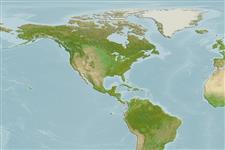Ikan bertulang rawan (sharks and rays) >
Rajiformes (Skates and rays) >
Arhynchobatidae (Softnose skates)
Etymology: Notoraja: Greek, noton = back + Latin, raja = fish, Raja sp. (Ref. 45335); martinezi: Named for Jimmy Martínez, an Ecuadorian Biologist..
Environment: milieu / climate zone / depth range / distribution range
Ekologi
laut batidemersal; kisaran kedalaman 1256 - 1472 m (Ref. 117110). Deep-water
Eastern Pacific, between Costa Rica and Ecuador.
Size / Weight / umur
Maturity: Lm ? range ? - ? cm
Max length : 47.5 cm TL jantan/; (Ref. 117110); 34.6 cm TL (female)
deskripsi pendek
Morfologi | Morfometrik
This heart-shaped, medium-size species is distinguished by the following characters: dark brownish dorsal and ventral surface; the disc is slightly wider 54.7 (51.7-55.2) %TL than long 51.6 (49.0-54.3) %TL; dorsal head length 21.3 (18.9-20.4) %TL; interspiracular width 6.3 (6.6-7.6) %TL; internarial space 8.4 (6.6-7.9) %TL; preorbital length 14.9 (13.0-14.9) %TL, 4.4 (3.8-4.9) times orbit length and 3.0 (2.9-3.3) times distance between eyes (interorbital space); tail width
at pelvic fin axil 1.5 (1.3-1.4) times its height; presence of a single, strong, hook-like, angled posteriorly preorbital thorn; disk with small, fine denticles, randomly distributed, slightly more abundant on the sides of the caudal region; long claspers (cloacal length) 23.8% TL and slim; long and slender tail, covered with abundant strong, thin, non aligned and posteriorly angled thorns, which differs from all other congeners; thin lateral tail folds merging at tail axil, thinner than tail width at any point and enlarged posteriorly; nasal lobes are expanded, nasal curtain maximum width 8.4 (7.8-9.5) %TL; anterior pelvic-fin lobe is longer than posterior 13.1 (16.2-16.8) %TL and 10.1 (7.8-9.8)% TL when straightened (shorter than posterior in natural position though); total pectoral-fin radials 65 (63-65); monospondylus centra 25 (24-26); predorsal diplospondylous centra 58 (60-65); total predorsal centra 83 (85-91); caudal centra 20 (22-25) total centra 118 (123-128) (Ref. 117110).
Female maturity and size at birth not known (but the smallest specimen taken was 24.3 cm TL) (Ref. 117110).
Life cycle and mating behavior
Kematangan | Reproduksi, perkembang biakan | Pemijahan | telur-telur | Fecundity | Larva
Concha, F.J., D.A. Ebert and D.J. Long, 2016. Notoraja martinezi sp. nov., a new species of deepwater skate and the first record of the genus Notoraja Ishiyama, 1958 (Rajiformes: Arhynchobatidae) from the eastern Pacific Ocean. Zootaxa 4098(1):179-190. (Ref. 117110)
Status IUCN Red List (Ref. 130435)
ancaman kepada manusia
Harmless
penggunaan manusia
informasi lanjut
Nama-nama umumSinonim (persamaan)metabolismePemangsaEkotoksikologiReproduksi, perkembang biakanKematanganPemijahanSpawning aggregationFecunditytelur-telurpekembangan telor
Umur / SaizPertumbuhanpanjang-beratpanjang-panjangukuran frekuensiMorfometrikMorfologiLarvaDinamika larvapemulihanKelimpahanBRUVS
AcuanBudidaya airprofil budidaya airStrainGenetikaElectrophoresesDiturunkanPenyakit-penyakitPengolahanNutrientsMass conversion
mitraGambarStamps, Coins Misc.Suara-suaraCiguateraKecepatanTipe renangArea insangOtolithsOtakPenglihatan / visi
Alat, peralatan
laporan khas
muat turun XML
Sumber internet
Estimates based on models
Phylogenetic diversity index (Ref.
82804): PD
50 = 0.5001 [Uniqueness, from 0.5 = low to 2.0 = high].
Bayesian length-weight: a=0.01000 (0.00244 - 0.04107), b=3.04 (2.81 - 3.27), in cm total length, based on all LWR estimates for this body shape (Ref.
93245).
Trophic level (Ref.
69278): 3.8 ±0.7 se; based on size and trophs of closest relatives
Daya lenting (Ref.
120179): sedang, Waktu penggandaan populasi minimum 1.4 - 4.4 tahun (Preliminary K or Fecundity.).
Fishing Vulnerability (Ref.
59153): Moderate vulnerability (38 of 100).
